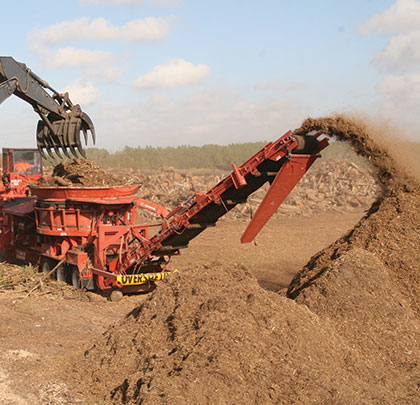When Hurricane Charley ran roughshod across central Florida in 2004, it was an undeniably catastrophic event, directly claiming eight lives and causing more than $13 billion in damage. The storm was a life-changer in so many ways, leaving tens of thousands homeless, shuttering businesses and generally making its presence felt long after it headed out to the Atlantic. For some, however, the hurricane had an inadvertently positive long-term impact. Realizing that the push to clean up needed help—and seeing it as a way to supplement their income—veteran firefighters Ron Raymond and Brian Hyland purchased a grapple truck to join in the effort. In doing so, they not only made their contribution to the recovery, but also built a new business, Debris & Roll-Off Service (DRS) upon that initial work. Today, through a combination of insightful planning, ability to gain a competitive edge, and unique equipment pairings—including self-designed collection trucks and a Morbark Model 1300 tub grinder— they’ve become one of the most innovative wood waste recycling companies in the region. Apparently every cloud (even those from a hurricane) does have a silver lining.
BUILDING A BETTER BUSINESS
Working with local dealer reps, Raymond and Hyland contracted to have a 60-yard container mounted to a rolloff chassis, then added a Prentice boom and Rotobec grapple. The game plan, says Raymond, was fairly simple.
“We would drop off 30-yard rolloff containers at customers’ sites throughout the area, then, because of the size of our new truck, be able to empty two of those smaller containers each time we went out. For larger customers with two containers, we would simply pull between them, empty them, and move on. The economics were basic: We would be making one trip, getting twice the volume, while using half the fuel and half the manpower. We worked our way up to about 100 rolloffs when the economy tanked.”
TIME TO REGROUP
The economic downturn hit DRS hard. Larger companies that owned landfills became fierce competition. DRS reevaluated its business and focused on landscape companies using containers. Raymond knew they could beat anyone’s price with their system, but material was still ending up in the landfill (at the same disposal cost as everyone else).
“We started questioning why all this material was just going to landfill and getting buried or used as alternative daily cover (ADC). We felt that recycling it would be a much better use for it and doing so would capitalize on the increased push on everyone’s part to go green. It all started to come together.”
GETTING INTO THE TUB
In late 2011, Raymond and Hyland started the wheels in motion to turn DRS into a viable recycling force in central Florida. Working with principals from Winter Park, Florida-based Hubbard Construction, they contracted to lease a 15-acre piece of land adjacent to the company’s Mid-Florida Materials Landfill to which material could be brought.
Because their loader and other equipment purchases were made through the Orlando branch of Nortrax—also the regional Morbark dealer—Raymond and Hyland met with them to discuss a grinder purchase.
“Once we showed we were genuinely interested in purchasing a grinder, the people from Morbark flew Brian and me up to Michigan to see their plant. While there, we were shown a used Model 1300 tub grinder that was in the process of being totally refurbished. The timing couldn’t have been better. With the budget we had, we saw it as a great investment, and we’ve been using it for the last year and a half.”
PRODUCT MIX
Of the material they take in, DRS uses the Model 1300 to create two products: mulch and a compost bulking agent. The mulch, created from material that has been double-ground through 2-inch and 3-inch screens, is primarily sold to an area firm that uses blower trucks to apply the product. The compost material, on the other hand, is green waste that is simply ground up and run through a 6-inch screen, then sent to companies that take it, add to it, and create their own compost.
Raymond says their current clientele is weighted toward the landscaping side—probably about 65 percent of their business is from such companies. While they scored points with them by emphasizing the recycling aspect of their business, ultimately it was economics that sealed the deal.
“We gave them a price that was hard to turn down—we were literally saving them 33 percent on their collection and dump fees,” he says. “They were paying $700 for two 30-yard containers, and I was doing both for $400. That’s quite a savings, and it’s proven popular—today we probably service 45 to 50 of the area’s largest landscape companies. In addition, we take in material from two of the three major theme parks in the area. The Morbark 1300 has been an outstanding performer for us—we took in over 150,000 cubic yards of material in 2012, and we are projecting to be over 200,000 yards this year.”
A BETTER FIT
That continual growth has resulted in DRS recently adding a Morbark Model 4600 XL Wood Hog horizontal grinder to work alongside their highly successful tub grinder. They feel the 4600 will enhance processing for the increased volumes and types of material they are experiencing as they move forward.
“Much of the success we’ve enjoyed thus far has been the result of us being innovative in our approach to the business,” says Raymond. “At the end of the day, though, we are just a couple of firemen who chased debris after a hurricane and turned it into a livelihood. We surrounded ourselves with the right people and made the right equipment choices.
Morbark has been instrumental in helping us grow our business—and there’s definitely more to come for DRS.” ■
For More Information:
For more information about Morbark and its equipment offerings, visit www.morbark.com.
_________________________________________________________________________
Modern Contractor Solutions, October 2013
Did you enjoy this article?
Subscribe to the FREE Digital Edition of Modern Contractor Solutions magazine.

Opportunity Howls


